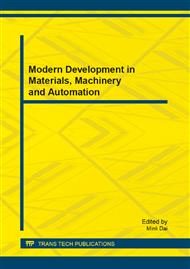[1]
P. Leone, A. Lanzini, G. Ortigoza-Villalba, R. Borchiellini, Operation of a solid oxide fuel cell under direct internal reforming of liquid fuels, Chemical Engineering Journal 191 (0) (2012) 349 – 355. doi: 10. 1016/j. cej. 2012. 03. 030.
DOI: 10.1016/j.cej.2012.03.030
Google Scholar
[2]
J. -H. Wee, Molten carbonate fuel cell and gas turbine hybrid systems as distributed energy resources, Applied Energy 88 (12) (2011) 4252–4263.
DOI: 10.1016/j.apenergy.2011.05.043
Google Scholar
[3]
H. Zhang, G. Lin, J. Chen, Performance analysis and multi-objective optimization of a new molten carbonate fuel cell system, International Journal of Hydrogen Energy 36 (6) (2011) 4015–4021.
DOI: 10.1016/j.ijhydene.2010.12.103
Google Scholar
[4]
G. De Lorenzo, P. Fragiacomo, Electrical and electrical-thermal power plants with molten carbonate fuel cell/gas turbine-integrated systems, International Journal of Energy Research 36 (2) (2012) 153–165.
DOI: 10.1002/er.1788
Google Scholar
[5]
G. De Lorenzo, P. Fragiacomo, A methodology for improving the performance of molten carbonate fuel cell/gas turbine hybrid systems, International Journal of Energy Research 36 (1) (2012) 96–110.
DOI: 10.1002/er.1789
Google Scholar
[6]
H. Jeong, S. Cho, D. Kim, H. Pyun, D. Ha, C. Han, M. Kang, M. Jeong, S. Lee, A heuristic method of variable selection based on principal component analysis and factor analysis for monitoring in a 300 kw mcfc power plant, International Journal of Hydrogen Energy 37 (15) (2012).
DOI: 10.1016/j.ijhydene.2012.04.135
Google Scholar
[7]
D. Sanchez, R. Chacartegui, J. M. de Escalona, A. Munoz, T. Sanchez, Performance analysis of a MCFC & supercritical carbon dioxide hybrid cycle under part load operation, International Journal of Hydrogen Energy 36 (16) (2011) 10327 – 10336.
DOI: 10.1016/j.ijhydene.2010.09.072
Google Scholar
[8]
D. Bakalis, A. Stamatis, Incorporating available micro gas turbines and fuel cell: Matching considerations and performance evaluation, Applied Energy 103 (2013) 607–617.
DOI: 10.1016/j.apenergy.2012.10.026
Google Scholar
[9]
L. Blum, R. Deja, R. Peters, D. Stolten, Comparison of efficiencies of low, mean and high temperature fuel cell systems, International Journal of Hydrogen Energy 36 (17) (2011) 11056 – 11067.
DOI: 10.1016/j.ijhydene.2011.05.122
Google Scholar
[10]
C. -G. Lee, D. -H. Kim, H. -C. Lim, Electrode reaction characteristics under pressurized conditions in a molten carbonate fuel cell, Journal of the Electrochemical Society 154 (4) (2007) B396–B404.
DOI: 10.1149/1.2434688
Google Scholar
[11]
S. Campanari, Carbon dioxide separation from high temperature fuel cell power plants, Journal of Power Sources 112 (1) (2002) 273 – 289.
DOI: 10.1016/s0378-7753(02)00395-6
Google Scholar
[12]
G. Discepoli, G. Cinti, U. Desideri, D. Penchini, S. Proietti, Carbon capture with molten carbonate fuel cells: Experimental tests and fuel cell performance assessment, International Journal of Greenhouse Gas Control 9 (2012) 372–384.
DOI: 10.1016/j.ijggc.2012.05.002
Google Scholar
[13]
L. Bartela, J. Kotowicz, Influence of membrane CO2 separation process on the effectiveness of supercritical combined heat and power plant, Rynek Energii 97 (6) (2011) 12–19.
Google Scholar
[14]
R. Nomura, N. Iki, O. Kurata, M. Kawabata, A. Tsutsumi, E. Koda, H. Furutani, System analysis of igfc with exergy recuperation utilizing low-grade coal, Vol. 4, 2011, p.243–251.
DOI: 10.1115/gt2011-46282
Google Scholar
[15]
W. Budzianowski, Target for national carbon intensity of energy by 2050: A case study of poland's energy system, Energy 46 (1) (2012) 575–581.
DOI: 10.1016/j.energy.2012.07.051
Google Scholar
[16]
H. Morita, M. Komoda, Y. Mugikura, Y. Izaki, T. Watanabe, Y. Masuda, T. Matsuyama, Performance analysis of molten carbonate fuel cell using a li/na electrolyte, Journal of Power Sources 112 (2) (2002) 509 – 518.
DOI: 10.1016/s0378-7753(02)00468-8
Google Scholar
[17]
T. Wolf, G. Wilemski, Molten carbonate fuel cell performance model, Journal of Electrochemical Society 30 (1983) 48–55.
DOI: 10.1149/1.2119681
Google Scholar


